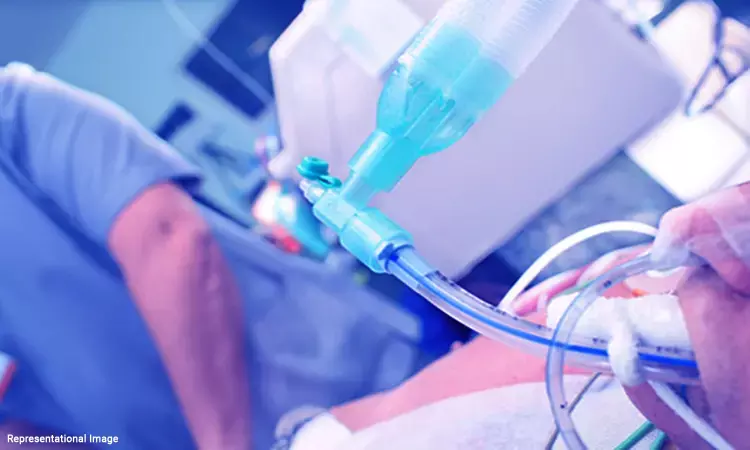- Home
- Medical news & Guidelines
- Anesthesiology
- Cardiology and CTVS
- Critical Care
- Dentistry
- Dermatology
- Diabetes and Endocrinology
- ENT
- Gastroenterology
- Medicine
- Nephrology
- Neurology
- Obstretics-Gynaecology
- Oncology
- Ophthalmology
- Orthopaedics
- Pediatrics-Neonatology
- Psychiatry
- Pulmonology
- Radiology
- Surgery
- Urology
- Laboratory Medicine
- Diet
- Nursing
- Paramedical
- Physiotherapy
- Health news
- Fact Check
- Bone Health Fact Check
- Brain Health Fact Check
- Cancer Related Fact Check
- Child Care Fact Check
- Dental and oral health fact check
- Diabetes and metabolic health fact check
- Diet and Nutrition Fact Check
- Eye and ENT Care Fact Check
- Fitness fact check
- Gut health fact check
- Heart health fact check
- Kidney health fact check
- Medical education fact check
- Men's health fact check
- Respiratory fact check
- Skin and hair care fact check
- Vaccine and Immunization fact check
- Women's health fact check
- AYUSH
- State News
- Andaman and Nicobar Islands
- Andhra Pradesh
- Arunachal Pradesh
- Assam
- Bihar
- Chandigarh
- Chattisgarh
- Dadra and Nagar Haveli
- Daman and Diu
- Delhi
- Goa
- Gujarat
- Haryana
- Himachal Pradesh
- Jammu & Kashmir
- Jharkhand
- Karnataka
- Kerala
- Ladakh
- Lakshadweep
- Madhya Pradesh
- Maharashtra
- Manipur
- Meghalaya
- Mizoram
- Nagaland
- Odisha
- Puducherry
- Punjab
- Rajasthan
- Sikkim
- Tamil Nadu
- Telangana
- Tripura
- Uttar Pradesh
- Uttrakhand
- West Bengal
- Medical Education
- Industry
What is the Effect of heated humidifier vs mist nebulizer on Endotracheal tube patency among intubated patients?

The process of humidification plays a crucial role in the comprehensive management of intubated patients undergoing invasive ventilation. Several studies have demonstrated the negative consequences of insufficient humidification on the respiratory system, including heightened respiratory effort, collapse of lung tissue (atelectasis), thick and dehydrated mucus, coughing and/or bronchospasm, obstruction or reduced openness of the endotracheal tube (ETT), and increased resistance to the flow of gases being delivered. The effects of the mist nebulizer and heated humidifier (HH) on the amount of endotracheal tube (ETT) blocking were compared by the authors.
This study consisted of a prospective, randomized controlled experiment including a total of 60 patients who had undergone overnight intubation and were spontaneously breathing. Of these patients, 30 were assigned to the HH group, while the other 30 were assigned to the mist nebulizer group. The quantitative measurement of endotracheal tube (ETT) patency decrease was conducted by calculating the difference in ETT volume between the pre-intubation and immediate post-extubation stages. This measurement was then compared between the two groups. Additionally, the study documented and analyzed the features of secretion, the temperature of inspired gas at the Y-piece, and the frequency of refilling the humidifier chamber.
The mist nebulizer group had a considerably greater decrease in endotracheal tube (ETT) capacity compared to the HH group (P-value 0.00026). The average temperature of the inspired gas, measured in degrees Celsius, was found to be significantly greater in the HH group (P-value < 0.0001). A higher proportion of patients in the mist nebulizer group had increased thickness (P-value 0.057) and reduced moisture content (P-value 0.005) of secretions in comparison to the HH group. There was no need for replenishing the humidifier chamber among the patients in the HH group, but the mist nebulizer group had an average frequency of 3.5 refills per patient.
The researchers reached the conclusion that the use of heated humidification (HH) in patients who are intubated overnight and undergoing spontaneous ventilation is linked to a reduced occurrence of undesired narrowing of the endotracheal tube (ETT) due to the presence of thick and dry secretions, as compared to the mist nebulizer. The use of HH as a consistent source of humidification has the potential to provide a dependable option that concurrently alleviates the burden on nursing personnel.
Reference-
Patil, Vijaya P.; Deb, Prakash; Agarwal, Vandana; Kumar, Pavan. Mist nebulizer versus heated humidifier on endotracheal tube patency in spontaneously breathing intubated patients: A prospective, randomized controlled trial. Journal of Anaesthesiology Clinical Pharmacology 39(1):p 51-55, Jan–Mar 2023. | DOI: 10.4103/joacp.joacp_121_21
MBBS, MD (Anaesthesiology), FNB (Cardiac Anaesthesiology)
Dr Monish Raut is a practicing Cardiac Anesthesiologist. He completed his MBBS at Government Medical College, Nagpur, and pursued his MD in Anesthesiology at BJ Medical College, Pune. Further specializing in Cardiac Anesthesiology, Dr Raut earned his FNB in Cardiac Anesthesiology from Sir Ganga Ram Hospital, Delhi.
Dr Kamal Kant Kohli-MBBS, DTCD- a chest specialist with more than 30 years of practice and a flair for writing clinical articles, Dr Kamal Kant Kohli joined Medical Dialogues as a Chief Editor of Medical News. Besides writing articles, as an editor, he proofreads and verifies all the medical content published on Medical Dialogues including those coming from journals, studies,medical conferences,guidelines etc. Email: drkohli@medicaldialogues.in. Contact no. 011-43720751


